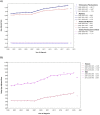A population-based study on incidence trends of myeloma in the United States over 2000-2020
- PMID: 38001246
- PMCID: PMC10673923
- DOI: 10.1038/s41598-023-47906-y
A population-based study on incidence trends of myeloma in the United States over 2000-2020
Abstract
Myeloma is one of the most common types of haematological malignancies. We aimed to investigate the incidence rates of myeloma by sex, race, age, and histological subgroups in the United States (US) over 2000-2020. Data were retrieved from the the Surveillance, Epidemiology, and End Results (SEER) 22 database. The International Classification of Diseases for Oncology version 3 morphological codes 9731, 9732, and 9734 were assigned for solitary plasmacytoma of bone, plasma cell myeloma, and extraosseous plasmacytoma, respectively. Average annual percent change (AAPC) and the pairwise comparison with the parallelism and coincidence were reported. All estimates were reported as counts and age-adjusted incidence rates per 100,000 individuals. Over 2000-2019, most of myeloma cases were among those aged at least 55 years (85.51%), men (54.82%), and non-Hispanic Whites (66.67%). Among different subtypes, plasma cell myeloma with 193,530 cases had the highest frequency over the same period. Also, there was a significant decrease in the age-standardized incidence rate of myeloma across all races/ethnicities in both sexes within all age groups (AAPC: - 8.02; 95% confidence interval (CI): - 10.43 to - 5.61) and those aged < 55 (AAPC: - 8.64; 95% CI - 11.02 to - 6.25) from 2019 to November 2020. The overall trends of myeloma incidence rates were not parallel, nor identical. There was an increase in myeloma incidence in both sexes, with a highly increasing rate, particularly among younger Hispanic and non-Hispanic Black women over 2000-2019. However, a remarkable decline was observed in the incidence rates following the COVID-19 pandemic in 2020.
© 2023. The Author(s).
Conflict of interest statement
The authors declare no competing interests.
Figures



Similar articles
-
Incidence Trends of Vulvar Cancer in the United States: A 20-Year Population-Based Study.Cancer Rep (Hoboken). 2024 Jun;7(6):e2120. doi: 10.1002/cnr2.2120. Cancer Rep (Hoboken). 2024. PMID: 39031816 Free PMC article.
-
Trends in solitary plasmacytoma, extramedullary plasmacytoma, and plasma cell myeloma incidence and myeloma mortality by racial-ethnic group, United States 2003-2016.Cancer Med. 2021 Jan;10(1):386-395. doi: 10.1002/cam4.3444. Epub 2020 Dec 3. Cancer Med. 2021. PMID: 33270992 Free PMC article.
-
Plasma Cell Myeloma - 20-Year Comparative Survival and Mortality of Three Plasma Cell Myeloma ICD-O-3 Oncologic Phenotypes by Age, Sex, Race, Stage, Cohort Entry Time-Period and Disease Duration: A Systematic Review of 111,041 Cases for Diagnosis Years 1973-2014: (SEER*Stat 8.3.4).J Insur Med. 2018;47(4):203-211. doi: 10.17849/insm-47-04-1-9.1. Epub 2019 Jan 22. J Insur Med. 2018. PMID: 30668210
-
Leukemias, myeloma, and other lymphoreticular neoplasms.Cancer. 1995 Jan 1;75(1 Suppl):381-94. doi: 10.1002/1097-0142(19950101)75:1+<381::aid-cncr2820751320>3.0.co;2-b. Cancer. 1995. PMID: 8001009
-
20-Year Comparative Survival and Mortality of Cancer of the Stomach by Age, Sex, Race, Stage, Grade, Cohort Entry Time-Period, Disease Duration & Selected ICD-O-3 Oncologic Phenotypes: A Systematic Review of 157,258 Cases for Diagnosis Years 1973-2014: (SEER*Stat 8.3.4).J Insur Med. 2019;48(1):5-23. doi: 10.17849/insm-48-1-1-19.1. Epub 2019 Oct 14. J Insur Med. 2019. PMID: 31609640
Cited by
-
Laryngeal cancer incidence trends in the United States over 2000-2020: a population-based analysis.Arch Public Health. 2024 Jul 10;82(1):106. doi: 10.1186/s13690-024-01333-1. Arch Public Health. 2024. PMID: 38987838 Free PMC article.
-
Neuropsychiatric Adverse Events with Monoclonal Antibodies Approved for Multiple Myeloma: An Analysis from the FDA Adverse Event Reporting System.Pharmaceuticals (Basel). 2024 Sep 25;17(10):1266. doi: 10.3390/ph17101266. Pharmaceuticals (Basel). 2024. PMID: 39458907 Free PMC article.
-
A population-based study on incidence trends of small intestine cancer in the United States from 2000 to 2020.PLoS One. 2024 Aug 19;19(8):e0307019. doi: 10.1371/journal.pone.0307019. eCollection 2024. PLoS One. 2024. PMID: 39159196 Free PMC article.
-
Time trends in multiple myeloma incidence and mortality across the BRICS from 1992 to 2021 and projection to 2046.BMC Public Health. 2025 May 13;25(1):1765. doi: 10.1186/s12889-025-22688-2. BMC Public Health. 2025. PMID: 40361119 Free PMC article.
-
Quantification of Total and Unbound Selinexor Concentrations in Human Plasma by a Fully Validated Liquid Chromatography-Tandem Mass Spectrometry Method.Pharmaceutics. 2025 Jul 16;17(7):919. doi: 10.3390/pharmaceutics17070919. Pharmaceutics. 2025. PMID: 40733127 Free PMC article.
References
MeSH terms
LinkOut - more resources
Full Text Sources
Medical

